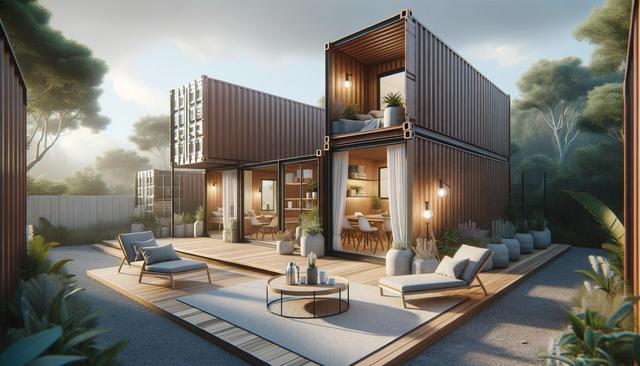What Are Container Homes?
Container homes are an increasingly popular form of alternative housing, built using repurposed steel shipping containers. These modular structures, once used for transporting goods across the globe, are now being reimagined as sustainable solutions for modern living. With their durability and affordability, container homes appeal to a wide range of people, from first-time homeowners to eco-conscious individuals seeking a smaller carbon footprint. As more people explore the potential of Containers Homes, the market has expanded to include a variety of styles and configurations, from single-unit studios to multi-container family homes.
The basic concept is simple: take a used shipping container, modify it with insulation, plumbing, electrical systems, and interior finishes, and transform it into a livable space. The result can be a compact yet functional dwelling that challenges traditional notions of home construction. With options like Fitted Out Shipping Containers for Sale and Move in Ready Container Homes, buyers can choose between DIY conversion projects or fully finished units that require minimal setup.
Advantages of Container Living
There are several compelling reasons why people are turning to Residential Shipping Containers as a housing solution. These homes offer a unique blend of affordability, speed of construction, and environmental responsibility. Some of the key benefits include:
- Cost-effectiveness: Compared to traditional houses, container homes often require less capital investment, especially when using Converted Shipping Containers for Sale.
- Faster build times: Since the basic structure already exists, construction can be completed in a fraction of the time it takes to build a traditional house.
- Eco-friendliness: Repurposing containers reduces waste and supports sustainable building practices.
- Modularity: Containers can be stacked, arranged, or expanded as needed, offering flexible living solutions.
These qualities make container homes an attractive option for individuals, couples, and even families who want a practical and unconventional living space.
Design Possibilities and Customization
One of the most exciting aspects of container homes is the wide range of design possibilities. Although the basic container shape is rectangular, creative architects and builders have developed innovative ways to customize these structures. Whether you are interested in a minimalist studio or a multi-level home, there’s room for personalization in every build. With options like Fitted Out Shipping Containers for Sale, buyers can select homes with pre-installed features like modern kitchens, full bathrooms, and energy-efficient systems.
Common design customizations include:
- Adding large windows and sliding doors for natural light
- Installing rooftop decks or patios
- Using eco-friendly materials for insulation and finishes
- Integrating solar panels and rainwater collection systems
These homes can be adapted for various climates and lifestyles, making them a flexible choice for a wide audience. Whether placed in urban areas, rural plots, or off-grid locations, container homes can be tailored to suit individual needs.
Buying Options and Market Trends
As container homes gain traction, the market has responded with a growing array of purchasing options. Buyers can now find Containers for Sale specifically intended for residential use, often with structural modifications already in place. For those looking to move in quickly, Move in Ready Container Homes offer a turnkey solution. These units are typically delivered fully assembled and include all necessary utilities and fittings, making them ideal for those who want a hassle-free start.
Meanwhile, the availability of Converted Shipping Containers for Sale continues to rise, giving buyers the choice between newly built models and creatively repurposed ones. Whether purchased through specialized vendors or custom builders, container homes are becoming more accessible and affordable. This trend is supported by increased interest in sustainable architecture and a desire for more flexible housing options.
With financing options and zoning regulations becoming more container-friendly in many regions, the path to owning a container home is becoming smoother for interested buyers.
Challenges and Considerations
While container homes offer many advantages, they also come with specific challenges that should be considered before making a decision. The process of converting a shipping container into a home requires careful planning and compliance with local building codes. Not all areas are zoned for container housing, which means potential buyers should investigate local regulations before purchasing or placing a unit.
Other considerations include:
- Insulation and ventilation: Metal containers can be prone to temperature extremes, so proper insulation and airflow are critical.
- Structural modification: Cutting into the steel frame for windows, doors, or expansion can affect structural integrity unless done correctly.
- Transportation and placement: Moving and installing containers may require special equipment and coordination with local authorities.
Despite these challenges, many homeowners find the benefits outweigh the drawbacks. By working with experienced professionals and choosing from reputable suppliers of Fitted Out Shipping Containers for Sale, many of these issues can be effectively managed.
Conclusion: Embracing Modern Living with Container Homes
Container homes offer a compelling alternative to traditional housing, combining cost-efficiency, sustainability, and design flexibility. With a growing market that includes options like Move in Ready Container Homes and Converted Shipping Containers for Sale, it’s easier than ever to explore this innovative lifestyle. Whether you’re looking for a primary residence, a vacation property, or even a backyard office, Containers Homes present a unique solution that aligns with modern values and practical needs. As the interest in Residential Shipping Containers continues to grow, these homes are likely to play an increasingly important role in the future of housing.




Leave a Reply